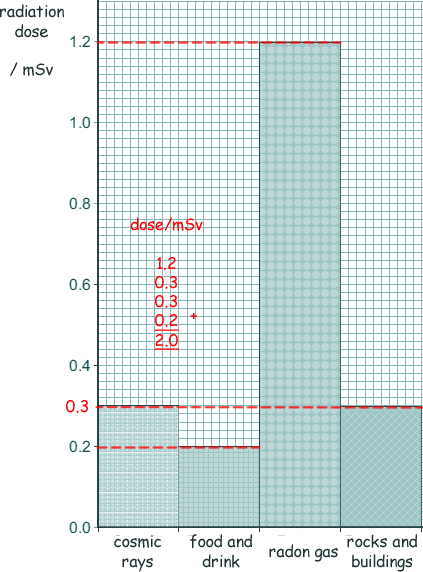GCSE Questions: Radioactivity
Q13. The bar chart below shows the total radiation dose that the average person in the UK gets from natural background radiation sources in one year.

(a)
(i) Calculate the percentage of the total radiation dose the average person in the UK receives from cosmic rays.
total radiation dose = 2.0 mSv 
0.3/2.0 = 0.15
15% 
[2 marks]
(ii) Over one year, a person may get a higher than average dose of radiation from cosmic rays. Suggest one reason why.
Any one from: 
 living at high altitude
living at high altitude
 working as a pilot or aircrew
working as a pilot or aircrew
 mountaineer
mountaineer
 (very frequent) flyer
(very frequent) flyer
[1 mark]
(iii) Some sources of background radiation are man-made. Name one man-made source of background radiation.
Any one from: 
 nuclear power (stations) or nuclear/radioactive waste
nuclear power (stations) or nuclear/radioactive waste
 nuclear weapons (testing) or nuclear bombs/fallout
nuclear weapons (testing) or nuclear bombs/fallout
 nuclear accidents or a named nuclear accident eg Chernobyl or Fukushima
nuclear accidents or a named nuclear accident eg Chernobyl or Fukushima
 radiotherapy, medical treatments involving radioactive sources, X rays or CT scans
radiotherapy, medical treatments involving radioactive sources, X rays or CT scans
Saying 'nuclear activity/radiation' was insufficient to get you a mark. Naming smoke detectors and industrial tracers was also insufficient to get you the mark.
[1 mark]
(b) The diagram shows the apparatus a teacher used to investigate the radiation emitted by a source.

(i) Before using the radioactive source the teacher measured the background radiation in her laboratory. She did this three times. The measurements were taken correctly but all three measurements were different.
Why were the three background measurements different?
Radioactive decay) is a random process  therefore background radiation in a location varies from one point in time to another.
therefore background radiation in a location varies from one point in time to another.
[1 mark]
(ii) Here are the results of her experiment
Thickness of aluminium
/ mm |
Counts in one minute |
Corrected count/minute |
2 |
350 |
330 |
| 4 |
68 |
48 |
6 |
20 |
0 |
The teacher changed the thickness of the aluminium between the source and the Geiger-Müller (GM) tube and recorded number of counts for each thickness.
The mean background measurement was 20 counts in one minute.
A student concluded that the radioactive source emits beta radiation. Explain how the results support this conclusion.
It cannot be alpha because that would have been totally absorbed by the thinnest aluminium sheet  and it cannot be gamma as the reduction by aluminium would be so minimal as not to be detectable - whereas a 6mm thickness sheet cut the count back to background count.
and it cannot be gamma as the reduction by aluminium would be so minimal as not to be detectable - whereas a 6mm thickness sheet cut the count back to background count.
[2 marks]
(iii) The teacher said that the source also emits alpha radiation. Describe how the investigation could be changed in order to show that the source emits alpha radiation.
You could replace the aluminium with very thin paper/card sheets  - increasing the thickness of the paper/card would result in a decrease in count
- increasing the thickness of the paper/card would result in a decrease in count  until you got to the count purely from beta radiation.
until you got to the count purely from beta radiation.
or
You could totally remove the aluminium and gradually increase the distance between source and GM tube from a very close distance to about 8 cm  - by the time you got to about 6cm of air the count would be at a count just from beta radiation as the alpha would have been absorbed by the air.
- by the time you got to about 6cm of air the count would be at a count just from beta radiation as the alpha would have been absorbed by the air.
[2 marks]
(Total 9 marks)








